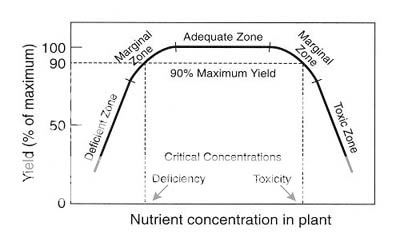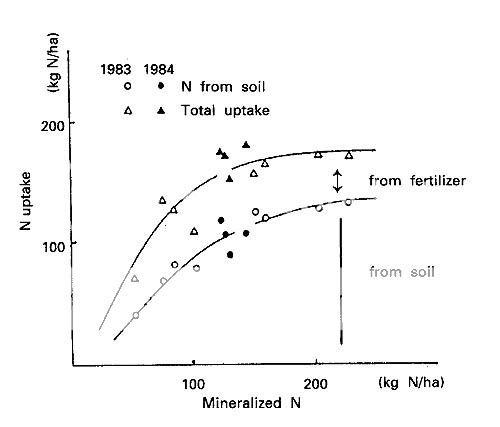laka;31423 said:
I do not understand why ferts are dosed in excess? Sure you say to avoid any possible deficiency. Let's look at one nutrient. Nitrate. In Tom's article, the maximum possible uptake of nitrate in a high light/CO2 tank is 1-4ppm. So why dose the recommended levels of 10-30ppm? The only explanation i see is plant mass. The more dense a tank set up, the quicker the plants may run into deficiency. So to avoid regular testing, one overdoses the tank to ensure nutrients do not run low. Is this correct?
What about the alternative of running the tanks lean ie. based on max. nutrient plant uptake, test weekly to confirm these levels are within this range ie. PPS.
LAKA
These are all good questions and ones I and others have heard and asked in the past.
There are few things going on here.
1st,
The word "excess" is misleading............every farmer I know adds "excess", but in research and in any Hydroponics control, we provide a "non limiting" control for an example to compare fertilizing treatments.
So thinking about it like that, as a
non limiting fertilizer method is a better wording, one that is not subjected to some waste based agenda, which matters little to any aquarist. If waste and excess are truly the goal, then a non CO2 approach with much slower growth rates, less electical cost should be used.
As far as I am aware, EI is the only and has been
the only non limiting nutrient method available.. So it invites criticisms more than any method that claims you should limit. I do not critque those methods based on semantical BS, I understand why they work in that context and test. Then discuss the trade offs. I also do not co opt other peoples methods and call them my own. I give credit where it is due.
I used it like any researcher might when doing fertilizer test growing a plant/crop/ornamental etc. This is not some unknown concept I pulled out of a hat. It really is basic elementary test methods used in agriculture, horticulture, livestock, Plant Ecology, Plant Molecular Biology etc etc..........
This way you can see/measure differences due to some other factors other than nutrients........ very easy way to rue things out, then you can focus on CO2 and light(which it most often my focus, not nutrients, they are easy to address and rule out). CO2 is the trickest nutient, but it's not an issue in agriculture testing.........only with aquatic plants since they are limited due to diffusion rates.
So I look at non levels as the lower min ranges for this and the upper bounds, where salt stress occurs from all the fertilizer salts. This is how you do risk assessment for fertilizers at the upper ranges. Now you know the range of
fertilizers that provide non limiting conditions. So now we can compare things like light and CO2 with the same reference point(which is why a control is used). There's plenty of variation between test, aquariums etc, but using a control addresses that variation.
2nd,
Concentration drives uptake rates which drives growth.
Would you not argue this same idea with CO2?
Is it not the same arguement to suggest that we keep 3ppm of CO2 with high light aquariums to avoid waste and excess CO2, the number one killers of fish and shrimp in planted tanks? Why add 10ppm? 20ppm? 30ppm? How much can we add? What about O2?
To date, not one person other than myself has shown that any KNO3 dosing is toxic to fish and shrimp and in my case, only shrimp at 160ppm+. Pretty high. Not one.
Aquarists are more concerned about fear of killing their critters than answering such questions. Some aquarists make mistakes and then are often amazed that their critters made it through. Then they have doubts about such wishful claims about high NO3's ill effects. I've found this with Shrimps lately, everyone's making lots of claims and no one is really doing much test to see if what they say can be confirmed.
Back to your question.
While adding say 1-4ppm of NO3 per day for the uptake of a planted tank works, it does depend on how much is there to start with. For maximal growth, Geoff(1966) found that the growth no longer improved with the addition of about 30ppm of NO3, the 90% range was 20ppm to about 80+ppm.
A huge target.
Growth dramatically dropped the lower the NO3 got from 20ppm.
Here's a graphical example of nutrient concentration on the bottom X axis(increases L to R), and the yield, or growt rate on the Y axis.
But the rates of growth relative to the ambient starting point, say 20ppm NO3, are also subjected to adaptation. Plants use more efficent enzymes to take up CO2, NO3, PO4 etc when they are high levels in the environment. So the plants adapts and makes a host of uptake transporting enzymes that match it's environment.
This way the plant can be best suited to maximize growth, flowering, seed production, tuber formation, competition etc.
The same is true for Rubsico and CO2.
This is why plants can live in many different conditions.
What is key here is that they are stable and that you reduce light to control rates of growth. In nature, we cannot control light, so we really are only left with maintaining stable conditions and limiting/adding nutrients. In aquariums, we can control every parameter influencing growth pretty easily.
All these enzymes require a lot of nitrogen to make the proteins. Plants can and do use enzymes like sources of N, when conditions change, they chop them up and make new more effienct enzymes able to take up smaller amount from the external environment, but it takes time and more energy to do so.
Plant has no choice but to try and adapt, they cannot run away like a critter.
But if there's no N or is always very limited, then the rates of growth are reduced.
Same for any nutrient, light or CO2.
Light is where it all starts, then CO2, then lastly, the nutrients.
I think this should answer the basics about why a plant will do okay in a wide range of nutrients. It also explains why EI produces such demand on CO2 and why the rates of growth are very fast.
Now, while I've stated that you do not need test, you most certainly may test and test well, in conjuction. There's no rule I've said that you cannot do that, only that based on the model, there's little need. I did until I convinced myself that there was need and looked into the maximal build up possible. Many folks go this route. No need to see based on faith alone, test and convince yourself.
"Infinite series" in math speak. See the PMDD thread on
The Krib (Aquaria and Tropical Fish) for more at the end, they discuss the same idea with Fe.
Regards,
Tom Barr




